How To Make My No-Fail Homemade Bread
I’m sure you know by now that I love making my no-fail homemade bread and teaching people how to do the same. There is something about feeling the dough in your hands, punching the dough down, and then molding the bread into loaves.
My mom taught me how to make bread and I can still remember the smell of baking bread in our home. I also loved watching my daughters sit on the kitchen counter or bar stools and making bread with me.
Now I get to make bread with my grandkids. Who doesn’t love watching a child mold a piece of dough into a masterpiece, right?
In every neighborhood where I have lived, I have taught my neighbors how to make bread if they were interested. I have taught people how to make bread in really nice kitchen stores (Bosch). I totally understand when people have no desire to learn how to make bread.
Maybe it’s because they didn’t grow up with homemade bread. Also, sometimes people tell me they “can’t” make bread. I get it. I really do.
I couldn’t make bread without fresh ingredients. I will teach you today how to make bread and you will be successful, I promise.
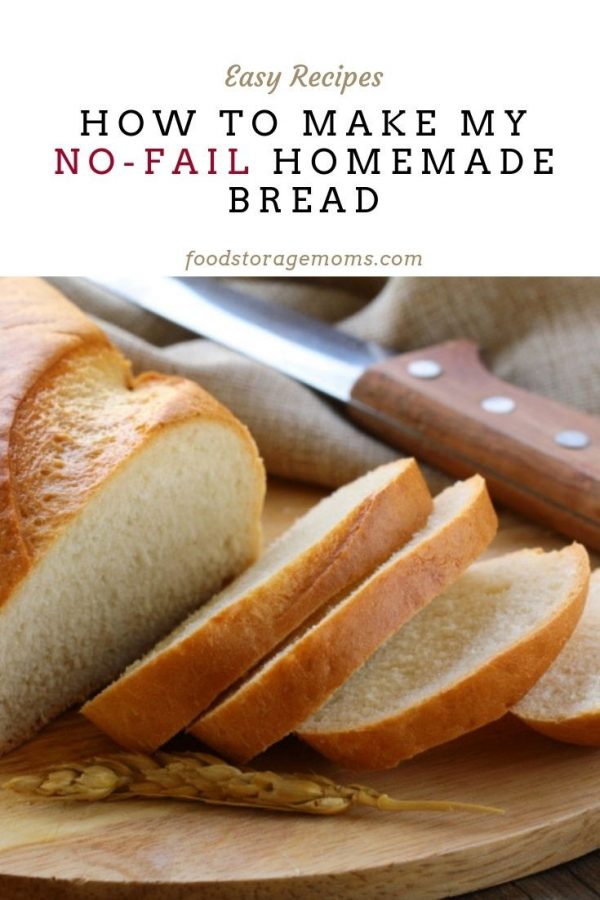
How To Make Bread:
These are some of my tips I share with those who need a little help to learn how to make bread. I jotted them down one by one as I thought of them.
Use only fresh ingredients. Here’s the deal, if your yeast package has been sitting on your pantry shelf for a month or more rather than being kept in the freezer or frig you may need to throw it out. It will probably not work.
I keep my excess SAF yeast in the freezer and the amount I use monthly in my refrigerator in an airtight container. I only use SAF yeast. That may sound a little snotty, but my bread turns out 99.9% of the time. Saf Instant Yeast, 1 Pound Pouch
I buy bread flour to use when I make white bread, cinnamon rolls, dinner rolls, breadsticks, or croissants. I buy the bread flour in 25 or 50-pound bags.
I place the flour in plastic buckets with a red Gamma lid. I only buy the amount of white flour I can use in 9-12 months. After that, it will become rancid and my bread will not turn out as it should.
The Gamma Seal Lid, Red You can buy the Gamma lids at stores like Walmart for about $8.00, give or take, plus tax of course. I buy red Gamma lids for my wheat and flour.
I color code all of my buckets. Blue is for sugar, yellow is for pasta and green is for all laundry products. I use other colors in the garage for my fuel like charcoal, pinecones, etc. I will talk about that another day.
Decide on the bread pan size that works for your family. I like to buy one pound loaves, but I only make bread for myself and my husband. Of course, I take a few loaves to special neighbors as well. Here is one that is similar to what I use: Fat Daddio Bread Pans
My bread dough can be frozen, but I use it within four weeks. I grease a gallon size bag and place some of the dough I want to use later AFTER the rising/proofing stage. Be sure and leave some room for expansion in the freezer.
When I want to use it I put the frozen bag in the refrigerator the night before. I let it thaw until about noon the next day, once I’ve pulled it from the refrigerator, depending on the temperature of the room. I grease the pans I want to use and mold the dough into bread, rolls, breadsticks or whatever.
Cover Dough With Plastic Wrap or Wet Towel
I cover the dough with greased plastic wrap or a wet towel while rising. Remove the plastic wrap or wet towel before baking. Bake according to the directions on my recipe.
I always bake mine at 350 degrees. One pound loaves will bake just right in about 27-30 minutes. Larger loaves will be around 35-45 minutes.
Yes, you can use a thermometer, but I don’t. When first learning to bake bread you may want to use one. The inner temperature at the bottom of the loaf after baking should be around 190 degrees.
Now, if the bread dough has eggs, butter, and milk the temperature should be around 205 degrees after baking in the bottom of the loaf.
Hearty/rustic bread should be baked until the temperature is 205 to 215 degrees after baking in the bottom of the loaf. You can see there is quite a spread in temperatures.
It’s all about practicing with your oven, your recipe, and the temperature in your house. If the air conditioner is blowing on your dough it will probably not rise or will take forever to rise. Here is a bread thermometer: Bread Thermometer
Freeze your bread the day you make it, except for the loaves you will consume within a day. Our homemade bread has zero preservatives, so it will go moldy quicker than commercially made bread.
The refrigerator makes the bread go stale and dry (dehydrates it and not in a good way). Bread is better if left on the counter in bags. I use bread bags like these: Bread Loaf Bags, Pack of 100 with Free Twist Ties with a recipe
You may want a hot loaf of bread to serve for dinner at the last minute. You can reheat a loaf of bread at 350 degrees for 15 minutes wrapped in foil and serve it warm with butter.
Bread Cutting Board:
It’s critical we have a good bread cutting board. Here’s the deal, you will ruin your very good bread knife or ceramic knives if you cut or slice with them on marble, granite, or tile countertops.
I prefer a bamboo cutting board with legs like this one: BOOS Bread Cutting Board I buy these for all my daughters when they get married. They last for years, you can sand them lightly if needed and oil them with mineral oil to keep them in great shape.
Bread Knife:
Here’s the deal, you need a really good bread knife that is serrated. I always say buy right the first time. I have two bread knives, so when one is getting sharpened locally I have another ready for use.
Here is a good one: Cutco Bread Knife
One thing to think about, ceramic knives cannot be sharpened, so you are better off to get a really good metal bread knife.
Now, let’s talk about the care of those very good knives we have in our house. They should never be put in the dishwasher. We do not want the blades sitting in water.
Please hand wash them and quickly dry them. They will last you for many years if taken care of properly.
Wheat:
You will want to store in the freezer your freshly ground wheat until you are ready to use it. I would use it within a month. Only grind what you need in that time period. The whole wheat flour at your local supermarkets is typically hard red wheat and it is not fresh, obviously because who knows how long it’s been sitting on the shelves.
I prefer to use hard white wheat, and yes, I grind it myself. If you buy whole wheat berries and grind the wheat yourself you will pay for your wheat grinder very quickly, depending on how many loaves of bread your family eats. The real bonus is that you’ll know what’s in the bread you make.
Hard White Wheat (the only kind I buy):
I buy mine from Costco when it goes on sale in 6-gallon buckets, the brand is Lehi Roller Mills. I also buy hard white wheat in #10 cans. I like to store my wheat in more than one way. Please make sure wherever you buy your wheat that it is clean and is at a very minimum triple washed.
I called Lehi Mills and I was told their wheat goes through seven cleaning processes to properly clean it. You can see why I buy Lehi Roller Mills Wheat. I quote from Lehi Roller Mills website: “Our Hard White Storage Wheat differs from our Red Storage Wheat slightly in color and flavor with just a little less protein, but it remains excellent for storage.
Our White Storage Wheat comes in ready-to-store buckets and lasts 30 plus years in storage. We use only hand-selected wheat that’s sourced, graded, and evaluated right at our mill.”
Hard Red Wheat:
I quote from Lehi Roller Mills: “Our Hard Red Storage Wheat is specially grown for Lehi Roller Mills. We’ve worked directly with seed breeders to develop this wheat specifically to enhance its baking quality and improve its flavor.
Lehi Roller Mills independently sources, grades, evaluates and cleans the wheat. When stored correctly in a cool, dry place it can last 30 plus years.”
Soft White Wheat:
Soft white wheat has a shorter shelf life, therefore, I rarely buy it. It’s mainly used for pastries.
Wheat Gluten:
This product makes my whole wheat bread softer. I only use one brand: All-Natural Vital Wheat Gluten
Dough Enhancer:
This product makes my white bread, rolls, and cinnamon rolls fluffier (it’s optional). I only use one brand: NutriMill Dough Enhancer 16oz Bag
Other Key Issues to Consider:
Bread pans cannot touch each other in the oven or the oven walls because they will not bake evenly and may even over bake your bread, in most cases.
Sunshine: It must be sunny on the day I am going to make bread. Now, is this an old wives tale, you ask? I don’t know, but one thing I do know is that if the clouds are dark and it’s raining my bread will not rise.
Nope, it will not. So there you have it. I only make bread on sunny days.
Grease your pans very well. Tap the bottom of the pan after baking and if it sounds hollow the bread is done. Place the bread on a cooling rack and then freeze it after it cools. Do this by placing the loaves in plastic bags as stated above.
Thumb Test
One way to make sure the dough is ready to mold into loaves is what I call the thumb test. Push your thumb into the dough as it has risen in a bowl or in the pan. Look for the thumb imprint.
If it stays indented the dough is ready to punch down and mold for baking. If the imprint bounces back, let the dough rise a little longer. I let my bread rise twice because I like fluffy bread. See the “test/proofing” discussion below for more details.
Never Let It Rise More Than 2-3 Hours
Never let the dough rise longer than 2-3 hours or the bread will taste yeasty. I never put my bread dough in the refrigerator overnight because it will taste like yeast.
Bread should be sticky, but not too sticky. If you add too much flour the bread will be dry and tough. No worries, you will get the hang of it, you really will. It may take a few tries, but the end result of your cooking adventures will be well worth the time and effort!
Use A Dough Scraper
Use a dough scraper, I use this to cut my dough into loaves and scrape the excess dough off the counter: OXO Good Grips Multi-purpose stainless steel scraper & chopper. I learned this when I taught bread-making at a Bosch store. Wow, my mom would have loved this tool!
Wash the dough off your hands with cold water, warm or hot water will start to “cook” the dough and make it stick to your hands even more.
Some people sprinkle flour on the countertop, I spray vegetable oil on the counter. Everyone makes bread a little differently, and that’s okay.
Test your bread dough, I’m not a scientist but this is what I do know:
Proofing your dough means you have let the dough rest, and then let it rise before baking it.
- push your thumb in the dough, if it totally disappears, then the dough is under-proofed (not ready to bake)
- push your thumb in the dough, if it dents about halfway back out, it’s perfect (ready to bake)
- push your thumb in the dough, if it stays totally pushed in, the dough is over-proofed (oops! It’s still good for fried bread)
This proofing technique you will learn by trial and error. Trust me, we have all had some loaves not bake exactly right, it’s okay, it still tastes fabulous!
Practice, practice, practice and never give up. You will make the perfect loaf of bread for your family, I promise.
These are all the recipes I have made for years and they are for sure no-fail recipes! Each post shows you step by step how to make the bread of your choice, whether it be whole wheat bread, white bread, cinnamon rolls, dinner rolls, and French bread.
I even have a YouTube available to show you HOW I make bread, start to finish. May God bless you in your efforts to get back to basics by making bread.
Whole Wheat Bread by Food Storage Moms
White Bread by Food Storage Moms
Dinner Rolls by Food Storage Moms
French Bread by Food Storage Moms
Food Storage Moms Bread Making YouTube
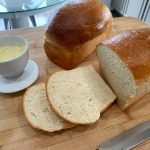
- 4 cups warm milk
- 8 tsp. SAF Instant Yeast
- 4 eggs
- 1/2 cup Oil (I use Olive oil)
- 8 teaspoons dough enhancer (optional)
- 3 tsp. Sea Salt
- 1 cup sugar
- 1 cup warm water
- 13-14 cups white bread flour
-
I start with a Bosch Mixer although you could make this in a bowl. I put the yeast, warm water, salt, oil, and sugar in the bowl.
-
I then add the eggs and lightly mix them in the Bosch so the eggs do not “cook”. Then I add the warm milk and flour slowly.
-
I continue to add flour until the bread dough pulls away from the sides of the Bosch bowl.
-
I knead for about 7-8 minutes.
-
I place the dough in a greased bowl and cover with plastic wrap.
-
I let the dough rise until it is double in size.
-
I punch down the dough then cut the dough into seven pieces, mold them, and place these in greased pans.
-
I let it rise once again (using the same plastic wrap) until it doubles and then I bake them at (350°F) = (176°C) degrees for 27 minutes. I lightly butter the tops of each loaf after baking while cooling on wire racks.
-
I store the loaves in bags and freeze the other loaves we will not eat in 3-4 days. Remember this bread has zero preservatives so it will go bad within 3-4 days.
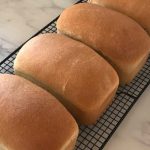
- 1 1/2 cups warm water
- 2 tablespoons olive oil
- 1/4 cup or so of honey
- 1/2 tablespoon salt
- 1/2 tablespoon SAF instant yeast
- 1/2 tablespoon dough enhancer
- 1/2 tablespoon wheat gluten
- 1/2 tablespoon lemon juice
- 3-1/2 to 4 cups whole wheat flour
-
Start adding the ingredients in the order shown above with one exception into your mixing bowl…start with 2 cups of flour and slowly add more flour until the dough pulls away from the sides of the bowl. I use a Bosch Mixer.
-
I grew up making bread without a mixer. It can be done by hand. I grew up letting my bread rise twice so I still do that. Old habits are hard to break!
-
I mix it for 10 minutes in my Bosch. Cover with greased plastic wrap until it doubles in size.
-
Punch down and form dough into two one-pound loaves. I let the dough rise one more time with greased plastic wrap.
-
Remove the plastic wrap Bake the bread at (350°F) = (76°C) degrees for 27-30 minutes. If your pans are larger you will bake your bread longer. You will love making whole-wheat bread, I promise!!

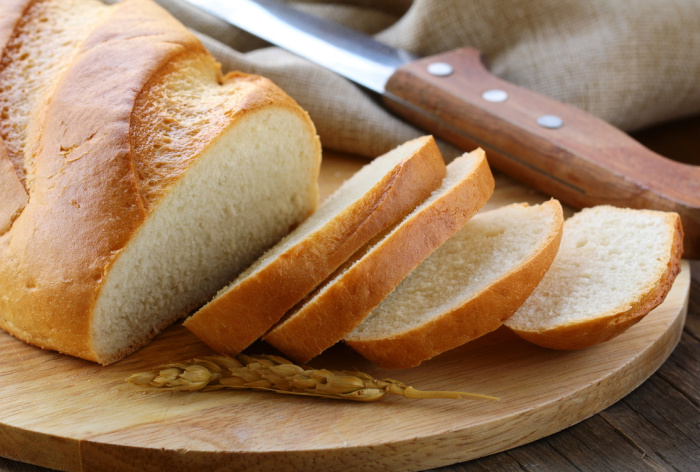

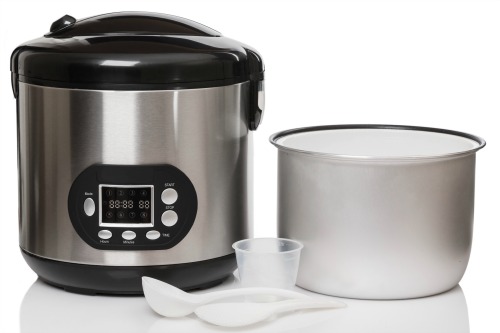
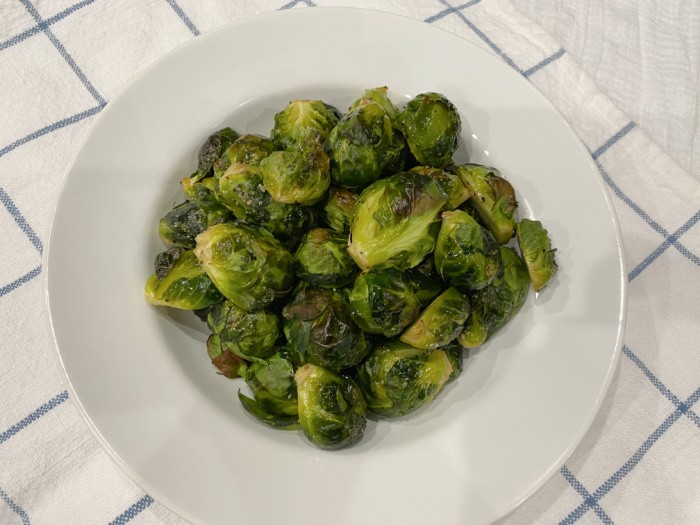

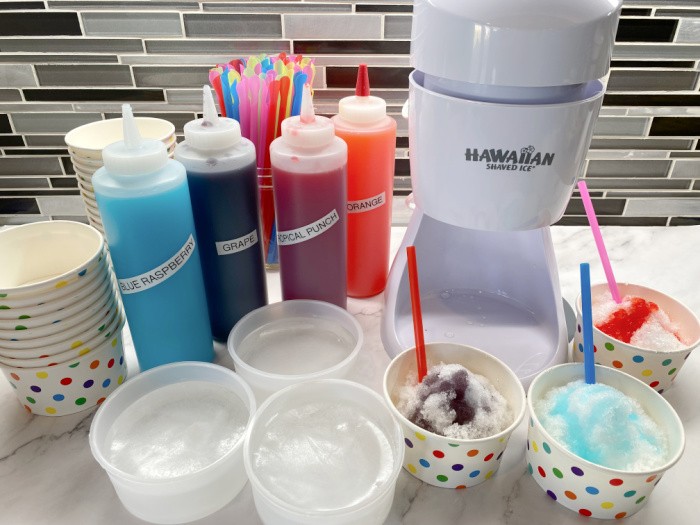
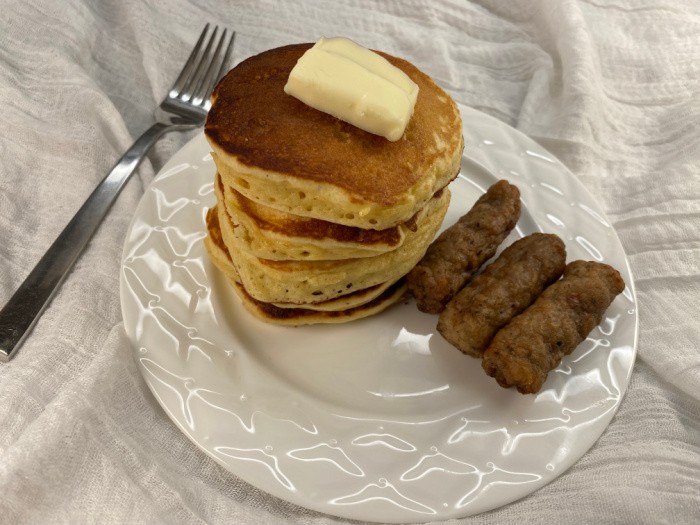
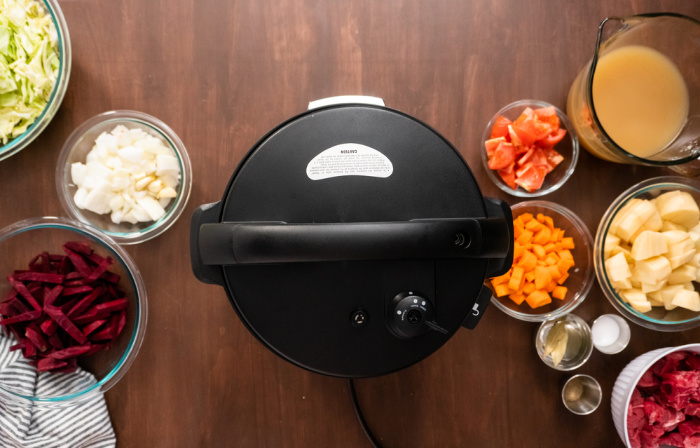













Thank you for making such an easy to follow recipe!
Hi Tiffany, you are so welcome! We need to pass on the skills of bread making! Linda
Strange….. I don’t have a 1/2 tablespoon measuring device ! making your WW recipe as
we speak…
Hi Dave, 1/2 tablespoon is 1-1/2 teaspoons. I should have put 1-1/2 teaspoons, thank you, my friend. Linda
I tried to put a smiley face on my remark.. but it wouldn’t let me! Wasn’t being critical…. just trying to be funny like normal.